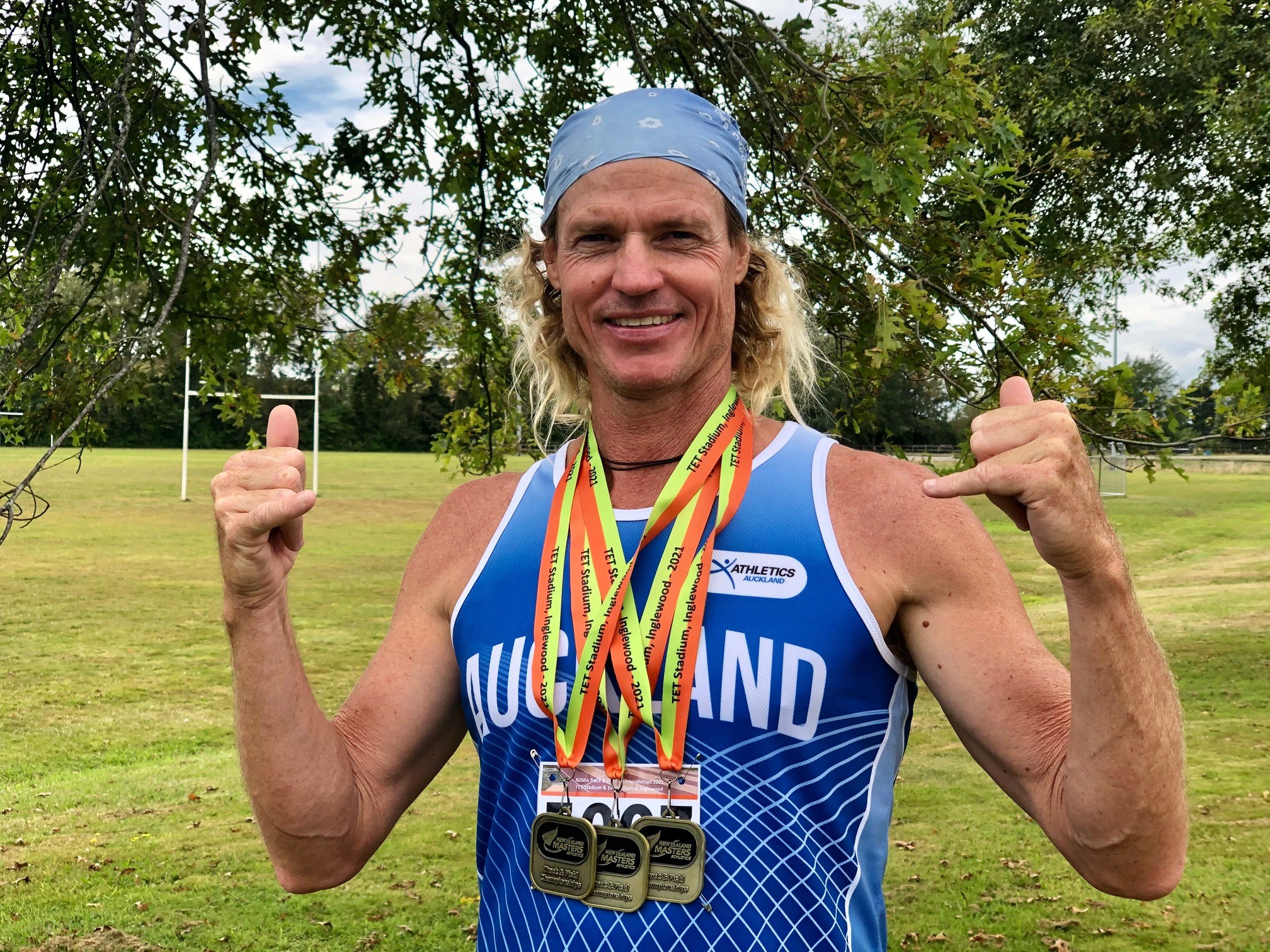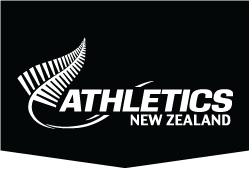News & Updates
Wim Luijpers is the grand master

Wim Luijpers has developed into one of New Zealand's most prominent masters athletes.
Leading Kiwi masters athlete Wim Luijpers is defying all logic and running quicker than ever despite his advancing years. Steve Landells spoke to the North Harbour Bays club member about his remarkable journey.
Like a fine wine Wim Luijpers just keeps getting better with age.
The 51-year-old, who lives on the tiny island of Rakino in the Hauraki Gulf, clocked a blistering 1500m mark of 4:12.0 in Papakura in November – just three seconds shy of the national record – his fastest time since re-engaging with the sport six years ago.
Yet how is it that Wim manages to achieve such phenomenal results and run faster times when all logic would say he should be slowing down?
To find out more we need to explore more Wim’s story in more detail – a story which straddles three continents, an innovative running method, a best-selling book and a quirky style of training limited largely to a hilly 1.8km piece of gravel road.
Born in the Netherlands, Wim moved with his Dutch family to live in Auckland at the age of three. As a schoolboy while attending Takapuna Grammar School he discovered a gift for running and came under the coaching guidance of Arthur Lydiard disciple Jack Ralston and Dave Norris among others. He was good enough to reach New Zealand Secondary Schools finals and set PB marks of 1:50 for the 800m and 3:50 for the 1500m but while he loved the movement of running and training with his mates he admits: “I never used to work very hard. I was known as the cat because I was pretty lazy. I often did the minimum amount of work to get the results.”
Wim took up a scholarship at the University of Connecticut and it was during his time in the US he became intrigued by the Feldenkrais Method – a form of body-oriented intervention designed to help people reconnect with their bodies by learning to move with greater efficiency.
After one year at Connecticut he quit to more actively pursue a greater interest in the Feldenkrais Method – which works on re-educating the nervous system and making it possible for adults to re-learn entrenched movement patterns. Out of this emerged a new formula for running which Wim created termed ‘Gentle Running.’
He later relocated to Austria and worked for a period with a doctor who advised running as a de-stress tool for businessmen – with Wim on hand to apply his movement fundamentals to largely novice runners.
“It was amazing as I’d suddenly be getting businessman to say why their knee suddenly did not hurt anymore,” he explains. “One such man was the CEO of Austrian TV who said he’d love to have the information I’d taught him written down. I said, ‘I can’t really write that well in German’ but he replied, ‘no worries because I can as journalist’ and so we worked on the book Gentle Running.
The book become a best-seller, shifting 150,000 copies and transformed Wim’s life. Overnight he became a big name in Austria regularly appearing on TV and radio. He carried out regular seminars in Austria, Germany and Switzerland wrote a further five books and worked with a whole range of people not only in the world of running but helping to improve the movement patterns of everyone from the world-beating Austrian ski team to musicians and dancers.
“I’ve had people come to me unable to do things they’ve wanted to because of injury, but through the change in movement patterns those injuries have cleared up,” explains Wim. “I love that feeling of giving people the chance to do things that they love to do.”
Around six years ago he returned to New Zealand settling on Rakino Island with his partner. Initially dividing his time between Rakino and Europe it was while back in his homeland of NZ where he reconnected once more with the competitive side of running.
Inspired to slip on his spikes and head to the track at AUT Millennium in Auckland he ran six 200m in around 30 seconds. He surprised himself not only how easy it felt but how much fun it was to run that fast again and for the first time in nearly 30 years since his time at the University of Connecticut he once again pursued the sport competitively.
“Russ Hoggard (the Auckland-based coach) was watching (the six 200s) and he told me, ‘mate, you are quick enough to run with the seniors never mind the masters. At the age of 46 I got back into training and got myself ready for the 2017 North Island Masters Championships.”
Despite only completing a couple of track sessions, Wim broke the North Island M45 record in the 1500m and within one second of the North Island 800m M45 record to complete the middle-distance double at Inglewood. Yet the Kiwi admits he was slightly perplexed by what he had achieved that day.
“Having run 3:50 as a kid, at that time I didn’t realise the times were good at all,” he explains. “All I knew is the event hurt a lot because I’d never run it for nearly 30 years!”
Since then, Wim has swept all before him as a masters athlete, winning numerous road, cross country and track titles. However, possibly the most impressive part of his success is that he is now running faster than ever during his time as a masters athlete.
Last March he chipped two seconds from the M50 mile record of 1964 Olympic 1500m bronze medallist John Davies, posting a swift 4:37.15. This year he trimmed a further three seconds from his 1500m PB as a masters athlete with a 4:12.0 in Papakura.
So what part has Gentle Running played in his progress?
“It’s played a very big part,” he admits. “I adopt a very gentle approach to not only training but how I look after my body,” he explains. “I’ve really experimented over the past couple of years what works for me. It is not about specific training guides but listening to the body.”
Based on Rakino island and restricted to training on an extremely steep 1.8km gravel road his training methods are far from textbook. Running around 100km a week his training is more based off feel and on four speeds – easy, steady, solid and hard.
With his longest runs of anything between 21-28km he says many of his runs are progressive – in which he runs a little quicker each lap of the island.
“The training is very organic, I grow with the training and if I feel a little niggle here or there I back off,” he explains.
Based in New Zealand for the past two years because Covid restrictions have not allowed him to return to Europe, his form has gone on a huge upward trend over the past couple of years. Last season he not only secured the M50 New Zealand mile record in his final track race of the domestic campaign he also scalped six seconds from his 1500m PB, running 4:15.
Taking the form into the winter he set a New Zealand 10km M50 road record of 34:45, remained unbeaten during the cross country season in his age-group and in his first race of the season on Auckland’s North Shore he raced to an impressive 3000m victory courtesy of a blistering last lap of 61 seconds.
“It was a slow race but I would be happy with a 61-second last lap in any race I run!” he remarks.
The 4:12 time set in Papakura offered yet further evidence of his outstanding current form.
For the future he hopes to run a sub-nine-minute 3000m (his current best is 9:13) while he is also targeting a sub-4:10 1500m (the national record is 4:09) and a 2:05 800m. He does not have a desire to compete internationally, but Wim still has one major goal for the future – the world 1500m M55 record of 4:12.35 set by Aussie Keith Bateman.
“I would love to one day lower that mark,” he explains. “The John Davies mile record took three years of planning, so I like to have longer goals to work towards.”
Yet what is it about the joy of running that appeals to Wim?
“It is not so much about where I’m running but more the movement itself,” he explains. “I don’t ever use Strava or wear a heart-rate monitor because I don’t think they are necessary to gain good results. My training is a lot more organic. I love that feeling of my feet touching the ground and the propulsion that comes out through the joints and hips. It is the sensation of running that brings the joy.”
